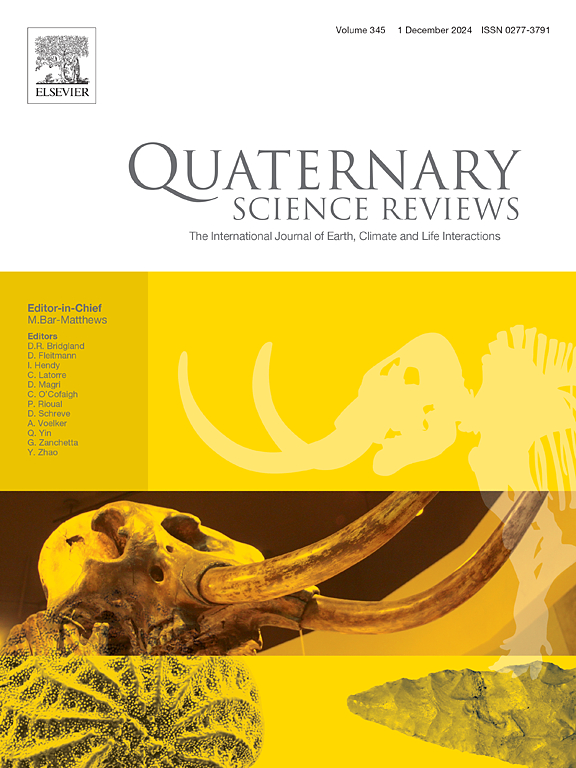Sedimentary architecture of the Brown Bank Formation (Dutch sector of the North Sea) reveals consecutive shallow marine depositional phases during the MIS 5-4 transition
IF 3.3
1区 地球科学
Q1 GEOGRAPHY, PHYSICAL
引用次数: 0
Abstract
Major climate cooling transitions have large impacts on the evolution of sedimentary depositional systems of shelf seas and coastal areas. These transitions are rarely preserved because they are prone to erosion during subsequent lowstands or, if preserved, buried too deep to reach with standard ground-truthing methods. As result, the relation between climate cooling and these sedimentary systems is still poorly understood. Severe climate cooling occurred during the Late Pleistocene MIS 5-MIS 4 transition, as captured within the shallow marine deposits of the Brown Bank Formation (Fm), which occurs between 0.1 m and 40 m below the present southern North Sea floor. To improve our understanding of the character and complexity of the depositional system, as well as the environmental response during the rapid climate cooling it portrays, we map the hitherto poorly constrained extent and architecture of the Brown Bank Fm within part of the Dutch sector of the North Sea. We document and map four seismic facies units (BB1-BB4) that are attributed to variations in tidal energy and pro-deltaic sediment supply. Pollen, diatom and mollusc assemblages reveal that the palaeoenvironment remained shallow marine throughout deposition and provide evidence for two cooling phases. The pollen assemblage also indicates that during this period forests changed to open woodlands in this period. Linking the palaeoenvironmental data and new luminescence ages of the four units with the Greenland NGRIP δ18Oice chronology, suggests that deposition of the units occurred during a relatively short time. The new analyses from the Brown Bank Fm suggest that the North Sea became disconnected from the Atlantic Ocean at its southern outlet (the Dover Strait) around the start of MIS 5a (ca. 88 ka) and that the floor of the southern North Sea became completely exposed around 72 ka.
布朗滩组(北海荷兰段)的沉积结构揭示了MIS 5-4过渡期间连续的浅海沉积阶段
主要的气候变冷转变对陆架海和海岸带沉积体系的演化有较大的影响。这些过渡层很少被保存下来,因为它们在随后的低洼地带容易受到侵蚀,或者即使保存下来,也埋得太深,无法用标准的地面测量方法到达。因此,人们对气候变冷与这些沉积体系之间的关系仍然知之甚少。严重的气候变冷发生在晚更新世MIS - 5-MIS - 4过渡期间,这在布朗滩组(Fm)的浅海沉积中得到了体现,该沉积位于目前北海南部海底以下0.1米至40米之间。为了提高我们对沉积系统的特征和复杂性的理解,以及它所描绘的快速气候变冷期间的环境反应,我们绘制了北海荷兰部分地区布朗滩Fm迄今为止缺乏约束的范围和结构。我们记录并绘制了四个地震相单元(BB1-BB4),这些地震相单元归因于潮汐能和前三角洲沉积物供应的变化。花粉、硅藻和软体动物的组合揭示了整个沉积过程中古环境一直是浅海环境,并为两个冷却阶段提供了证据。花粉组合也表明这一时期森林向开阔林地转变。将四个单元的古环境资料和新发光年龄与格陵兰岛NGRIP δ 18voice年代学相结合,表明四个单元的沉积时间相对较短。来自布朗银行Fm的新分析表明,北海在MIS 5a(约88 ka)开始时,在其南部出口(多佛海峡)与大西洋分离,北海南部的海底在72 ka左右完全暴露出来。
本文章由计算机程序翻译,如有差异,请以英文原文为准。
求助全文
约1分钟内获得全文
求助全文
来源期刊

Quaternary Science Reviews
地学-地球科学综合
CiteScore
7.50
自引率
15.00%
发文量
388
审稿时长
3 months
期刊介绍:
Quaternary Science Reviews caters for all aspects of Quaternary science, and includes, for example, geology, geomorphology, geography, archaeology, soil science, palaeobotany, palaeontology, palaeoclimatology and the full range of applicable dating methods. The dividing line between what constitutes the review paper and one which contains new original data is not easy to establish, so QSR also publishes papers with new data especially if these perform a review function. All the Quaternary sciences are changing rapidly and subject to re-evaluation as the pace of discovery quickens; thus the diverse but comprehensive role of Quaternary Science Reviews keeps readers abreast of the wider issues relating to new developments in the field.
 求助内容:
求助内容: 应助结果提醒方式:
应助结果提醒方式:


